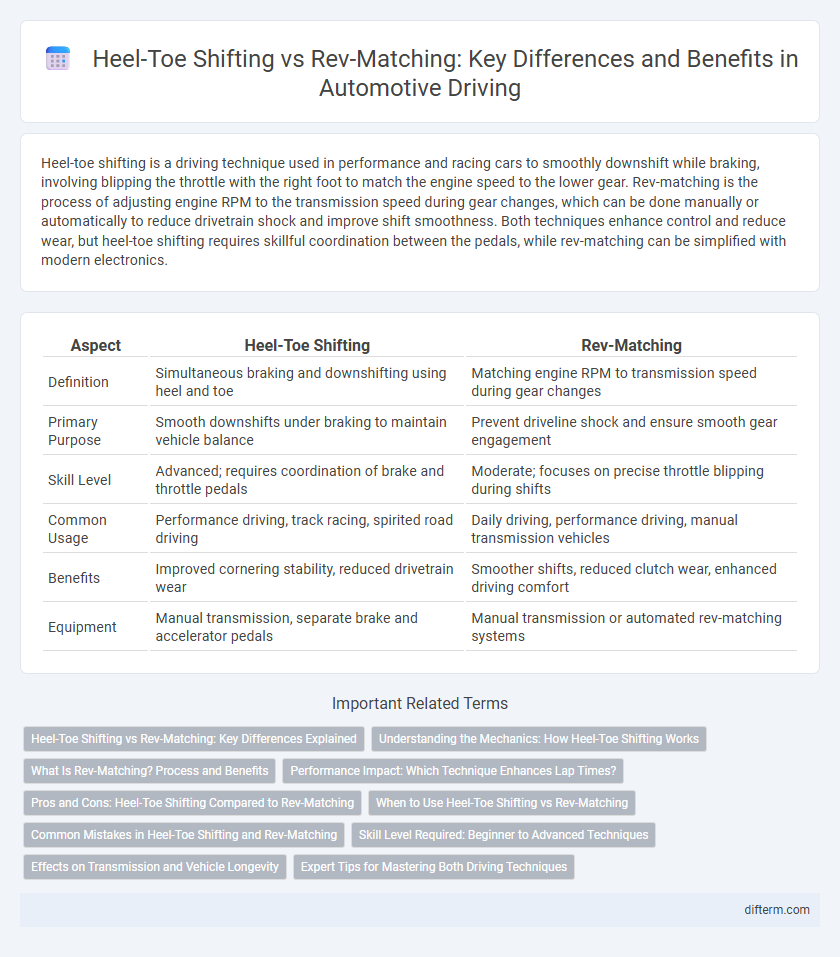Heel-toe shifting is a driving technique used in performance and racing cars to smoothly downshift while braking, involving blipping the throttle with the right foot to match the engine speed to the lower gear. Rev-matching is the process of adjusting engine RPM to the transmission speed during gear changes, which can be done manually or automatically to reduce drivetrain shock and improve shift smoothness. Both techniques enhance control and reduce wear, but heel-toe shifting requires skillful coordination between the pedals, while rev-matching can be simplified with modern electronics.
Table of Comparison
| Aspect | Heel-Toe Shifting | Rev-Matching |
|---|---|---|
| Definition | Simultaneous braking and downshifting using heel and toe | Matching engine RPM to transmission speed during gear changes |
| Primary Purpose | Smooth downshifts under braking to maintain vehicle balance | Prevent driveline shock and ensure smooth gear engagement |
| Skill Level | Advanced; requires coordination of brake and throttle pedals | Moderate; focuses on precise throttle blipping during shifts |
| Common Usage | Performance driving, track racing, spirited road driving | Daily driving, performance driving, manual transmission vehicles |
| Benefits | Improved cornering stability, reduced drivetrain wear | Smoother shifts, reduced clutch wear, enhanced driving comfort |
| Equipment | Manual transmission, separate brake and accelerator pedals | Manual transmission or automated rev-matching systems |
Heel-Toe Shifting vs Rev-Matching: Key Differences Explained
Heel-toe shifting and rev-matching are advanced driving techniques used to optimize gear changes during performance driving. Heel-toe shifting combines braking and downshifting simultaneously by using the right foot to brake and the heel or toe to blip the throttle, maintaining engine RPMs for smoother transitions. Rev-matching involves precisely matching the engine speed to the transmission speed before engaging the clutch, reducing drivetrain shock and improving control without necessarily braking.
Understanding the Mechanics: How Heel-Toe Shifting Works
Heel-toe shifting involves braking with the heel while blipping the throttle with the toe to match engine RPM for smooth downshifts, preventing drivetrain shock and maintaining vehicle stability. This technique requires precise timing and coordination between the brake, throttle, and clutch pedals to synchronize engine speed with wheel speed during corner entry. Proper execution of heel-toe shifting enhances control in performance driving, reduces wear on transmission components, and improves lap times on track.
What Is Rev-Matching? Process and Benefits
Rev-matching is a driving technique used to synchronize the engine speed with the transmission speed during downshifting, preventing drivetrain shock and ensuring smooth gear transitions in performance driving. The process involves blipping the throttle to raise engine RPM to match the lower gear's speed before engaging the clutch, enhancing vehicle control and reducing wear on transmission components. Benefits include improved cornering stability, smoother acceleration, and prolonged longevity of the clutch and gearbox in manual transmission vehicles.
Performance Impact: Which Technique Enhances Lap Times?
Heel-toe shifting optimizes braking and gear changes simultaneously, maintaining engine RPM and enhancing cornering stability, which directly improves lap times. Rev-matching smooths downshifts by synchronizing engine speed with transmission input, reducing drivetrain shock and preserving tire grip during acceleration out of corners. Studies show heel-toe shifting offers greater overall lap time gains in high-performance driving by integrating precise brake modulation with seamless gear changes.
Pros and Cons: Heel-Toe Shifting Compared to Rev-Matching
Heel-toe shifting enhances smooth downshifts during cornering by allowing simultaneous brake and throttle control, reducing drivetrain shock and maintaining vehicle balance, but it requires precise timing and practice to master. Rev-matching improves engine speed synchronization with the transmission, minimizing wear on the clutch and gearbox, and is easier to learn than heel-toe shifting but offers less control during aggressive driving scenarios. Both techniques reduce drivetrain stress, but heel-toe shifting provides superior control during high-performance driving, while rev-matching is more accessible for daily driving and novice enthusiasts.
When to Use Heel-Toe Shifting vs Rev-Matching
Heel-toe shifting is best used during aggressive driving scenarios such as track racing or spirited mountain driving, where smooth downshifts and maintaining vehicle stability are crucial. Rev-matching suits everyday driving conditions and helps prevent drivetrain shock by synchronizing engine speed to the transmission input shaft during gear transitions. Utilizing heel-toe shifting when cornering at high speeds enhances control, while rev-matching improves longevity and comfort during regular downshifts.
Common Mistakes in Heel-Toe Shifting and Rev-Matching
Common mistakes in heel-toe shifting include improper brake modulation, leading to jerky deceleration, and misalignment of the heel and toe causing missed downshifts or over-revving. In rev-matching, drivers often fail to precisely match engine RPM with the lower gear speed, resulting in drivetrain shock and increased wear on the transmission components. Consistent practice and attention to throttle control are essential to avoid these errors and ensure smooth, efficient gear transitions in performance driving.
Skill Level Required: Beginner to Advanced Techniques
Heel-toe shifting demands advanced coordination and timing, making it ideal for experienced drivers aiming to improve vehicle control during downshifts. Rev-matching, although requiring practice, is more accessible to beginners as it primarily involves matching engine RPM to the target gear to achieve smoother transitions. Mastering both techniques enhances driving precision, with heel-toe shifting serving as a higher-skill refinement of rev-matching fundamentals.
Effects on Transmission and Vehicle Longevity
Heel-toe shifting reduces drivetrain shock by synchronizing engine speed with wheel speed during downshifts, minimizing gear clash and wear on the transmission components. Rev-matching smooths the engagement of the clutch and gears, which lowers stress on synchromesh rings and extends the lifespan of the gearbox. Both techniques promote vehicle longevity by preserving transmission integrity and enhancing overall driveline durability.
Expert Tips for Mastering Both Driving Techniques
Heel-toe shifting and rev-matching are advanced driving techniques essential for smooth gear transitions and maintaining vehicle balance during cornering. Expert drivers emphasize precise throttle control and perfect timing, ensuring engine RPM aligns with wheel speed to prevent drivetrain shock and optimize performance. Practicing these methods on performance cars, such as those with manual transmissions and limited-slip differentials, enhances cornering efficiency and prolongs clutch life.
heel-toe shifting vs rev-matching Infographic

 difterm.com
difterm.com